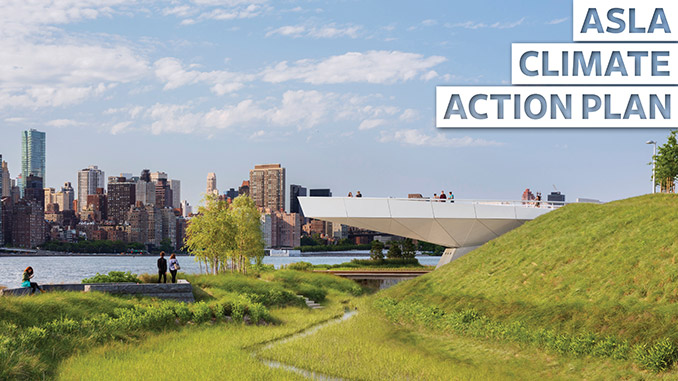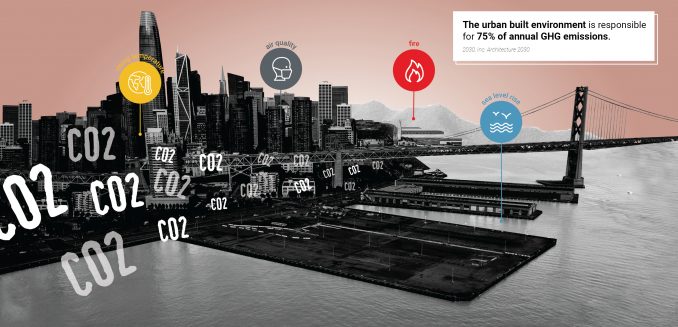
The American Society of Landscape Architects (ASLA) has recently released the ASLA Climate Action Plan and the Climate Action Field Guide for ASLA Members that set new goals and a pathway for landscape architects to achieve zero greenhouse gas emissions in their projects and operations and increase carbon sequestration by 2040.
The Climate Action Plan was developed by a high-profile Task Force of five landscape architects chaired by Pamela Conrad, ASLA, founder of Climate Positive Design, and a 17-member Advisory Group. It outlines a bold vision for 2040 and a set of 71 actions to be taken by 2025.
Landscape architects are scaling up efforts to have the greatest impact on Climate Change. Through the three goals of practice, equity and advocacy of the Climate Action Plan, we can take action every day working with communities to reach zero emissions by 2040, while providing multiple ecological, social and health benefits. Landscape architects are uniquely qualified to be climate leaders and to go beyond zero.
Pamela Conrad, ASLA, founder of Climate Positive Design
By 2040, all landscape architecture projects will simultaneously:
- Achieve zero embodied and operational emissions and increase carbon sequestration
- Provide significant economic benefits in the form of measurable ecosystem services, health co-benefits, sequestration, and green jobs
- Address climate injustices, empower communities, and increase equitable distribution of climate investments
- Restore ecosystems and increase and protect biodiversity

“Landscape architects are already helping communities achieve this vision. As we increasingly experience the impacts of the climate and biodiversity crises, we know we need to act faster. We are the only design professionals who bring all the pieces together to plan and design what communities need to prepare themselves for a changing world,”
ASLA President Eugenia Martin, FASLA.
The ASLA Climate Action Plan is rooted in the three goals (practice, equity, and advocacy) and six initiatives of IFLA Climate Action Commitment.


To accomplish the plan, ASLA, as a non-profit association, has also committed to achieving zero emissions in its operations by 2040. ASLA is calculating baseline Scope 1, 2, and 3 emissions for its 2022 Conference on Landscape Architecture in San Francisco and headquarters operations in Washington, D.C. and has committed to reducing its overall emissions by 20% by 2024. ASLA will use its own journey to zero as a learning opportunity for its members, EXPO exhibitors, and partner organizations.
“ASLA has developed its first Climate Action Plan in the spirit of great optimism. We envision communities becoming healthier and economically stronger because they have committed to drawing down carbon, restoring ecosystems and increasing biodiversity, and reducing reliance on vehicles – all while ensuring everyone in their community has equitable access to these benefits,”
ASLA CEO Torey Carter-Conneen
A companion to the plan – the Climate Action Field Guide for ASLA Members – provides best practice guidance, toolkits, and resources for ASLA members and their firms and organizations, along with corporate partners, to achieve the 2040 vision.

The Field Guide features six toolkits covering 18 strategies, with guidance on how to:
- Design Climate Positive Landscapes
- Design Pedestrian, Cyclist, and Public Transit-Centric Communities
- Reduce Energy Use and Support Renewables
- Help Communities Adapt to Climate Impacts
- Explore Pathways to Financial Sustainability with Communities
- Protect and Increase Biodiversity
- Learn from Indigenous Communities Through Collaboration
- Build Climate Coalitions
Conrad will represent ASLA and highlight the vision and goals of the ASLA Climate Action Plan at the United Nations Framework Convention on Climate Change (UNFCCC) COP27 in Sharm El-Sheikh, Egypt.
